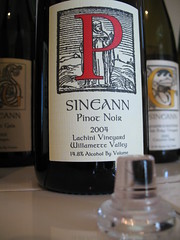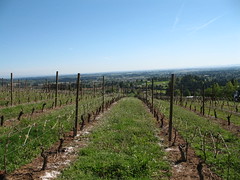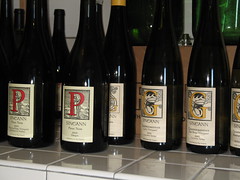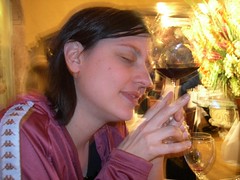Peter Rosback, Sineann Winery
 For many small Pinotphile winemakers in the Willamette, the grape is a like a puzzle that can be put together many different ways to achieve different pictures. Choice of clones, in which chunk of land to grow those particular clones, out of which block of that chunk of land to harvest, and which of the wines from the particular block in the specific chunk of land to choose to bear the label.
For many small Pinotphile winemakers in the Willamette, the grape is a like a puzzle that can be put together many different ways to achieve different pictures. Choice of clones, in which chunk of land to grow those particular clones, out of which block of that chunk of land to harvest, and which of the wines from the particular block in the specific chunk of land to choose to bear the label.This is a pursuit of Pinot Noir at the height of meticulosity. And Pinot Geek-osity. At Sineann winery, it results in several vineyard designated Pinot Noirs, all very broad shouldered, intense and high-octane, each with it's own distinct declaration of identity.
Peter Rosback is as intense as his wines. It didn't surprise me at all to learn that he was a hockey player, not because he's a large guy, but because he's...let's say: challenging. Not a subtle guy. Twice I was introduced thusly: "This one's from Texas, she's the one responsible for letting that guy out of the state!" The first time truly was enough (he made up for it later by putting a 375 of Pinot in my palm as I left). His enthusiasm for variety is very infectious, though, and by the time I left, I'd tasted through all seven of his current 2004 Pinots, a few Merlot or Cab blends, three Gewurtzes, one Pinot Gris and a couple of late harvest wines, and so many '05 barrel samples, I lost count.
My time with Mr. Rosback was fit precariously among a trickling in of men who were gathering with him for some pre-dinner barrel tasting. I was lucky to meet two of the men also responsible for Sineann's success--the amiable Kevin Chambers, owner of the beloved Resonance Vineyard, and Hal Medici of Medici vineyards (who stuck up for me when the Texas jokes broke out. Thank you, sir, for your graciousness).
Interview with Peter Rosback of Sineann Vineyards
How'd you get started?
 Well, I like wine. I moved here in 1980 from Indiana, and we had a small, burgeoning wine industry. I had a friend, I used to go pick peaches at his place every August. And picking peaches, we'd walk by his small Pinot Noir vineyard, pick the peaches, which were incredible, and walk back. I also had a friend who had the equipment so I thought, okay, for very little money, we could try making wine. That was back in 1985. We made ten gallons, it was a blast seeing the stuff change from this incredible fruit...ferments and turns into this raw, yeast filled, somewhat tart alcoholic substance. And then it mellows out, goes through malolactic fermentation and turns into beautiful Pinot Noir. I was hooked, through that first batch. I made more the next year, more the next year, pretty soon I was making the legal limit of what they'll let you make at home. After a few years of doing that I started helping out at a local winery, Elk Cove. I enjoy making wine so that gave me a chance to help do it on an industrial scale. I used to take my vacation from my engineering job--a day in the winery, a day back in the office--through harvest, as a volunteer. After doing that for a couple of years, they brought on David O'Reilly to be their marketing guy. We used to share food...at harvest, that was the ethic, to share food and wine. He got to try the wines I was making, and after trying the zinfandel a couple times, he said, why don't we get a couple of tons and make it into a commercial wine? It's got a story, it's good wine, he thought we might be able to sell it. Year by year, we added vineyards and grew. Eventually I ran out of time to do both engineering and winemaking. So I dropped the engineering.
Well, I like wine. I moved here in 1980 from Indiana, and we had a small, burgeoning wine industry. I had a friend, I used to go pick peaches at his place every August. And picking peaches, we'd walk by his small Pinot Noir vineyard, pick the peaches, which were incredible, and walk back. I also had a friend who had the equipment so I thought, okay, for very little money, we could try making wine. That was back in 1985. We made ten gallons, it was a blast seeing the stuff change from this incredible fruit...ferments and turns into this raw, yeast filled, somewhat tart alcoholic substance. And then it mellows out, goes through malolactic fermentation and turns into beautiful Pinot Noir. I was hooked, through that first batch. I made more the next year, more the next year, pretty soon I was making the legal limit of what they'll let you make at home. After a few years of doing that I started helping out at a local winery, Elk Cove. I enjoy making wine so that gave me a chance to help do it on an industrial scale. I used to take my vacation from my engineering job--a day in the winery, a day back in the office--through harvest, as a volunteer. After doing that for a couple of years, they brought on David O'Reilly to be their marketing guy. We used to share food...at harvest, that was the ethic, to share food and wine. He got to try the wines I was making, and after trying the zinfandel a couple times, he said, why don't we get a couple of tons and make it into a commercial wine? It's got a story, it's good wine, he thought we might be able to sell it. Year by year, we added vineyards and grew. Eventually I ran out of time to do both engineering and winemaking. So I dropped the engineering.(Current case production: 9,000 in 2005)
You've got seven Pinots that we've tasted today. That tells me Pinot Noir is pretty fascinating to you.
 Well, first of all, if you look at all my wines, most of them are vineyard designated. It's interesting to me, and others, to have the land express itself in wines. So if the vineyards I get have fruit that makes distinctly good wine, it gets a label. I mean, you tasted three different Gewurtztraminers, they were all different, yet they were made in exactly the same fashion. And Pinot Noir is said to be the one that expresses terroir best...you know, the difference between sites?
Well, first of all, if you look at all my wines, most of them are vineyard designated. It's interesting to me, and others, to have the land express itself in wines. So if the vineyards I get have fruit that makes distinctly good wine, it gets a label. I mean, you tasted three different Gewurtztraminers, they were all different, yet they were made in exactly the same fashion. And Pinot Noir is said to be the one that expresses terroir best...you know, the difference between sites?Yes.
Well, that's certainly fascinating to me, and it works well in a business sense. They sell very well, so...I'm not inclined not to do it. I get Pinot Noir off of maybe a dozen vineyards or so, maybe close to fifteen different blocks, and I choose different blocks or maybe the whole vineyard to become the vineyard designates.
Can you boil down for me the most important qualities you look for in a great Pinot Noir?
Wow, that would be like wine in general...which is just depth and breadth of flavor...I like aromatics, although my wines don't tend to be real aromatically expressive in their youth. I think I react best to wines that have a big feel in the mouth, you know they're there, they have a presence. Also I like wines that have a long finish.
Tell me about the glass enclosures.
It's a German system, Alcoa in Germany came up with this. I was told it used to be used for sealing medical supplies, and they adapted it to wine use. We've all been looking for a replacement for cork. TCA ruins two to fifteen percent of wines, depending on who you listen to. The plastic corks cause wine to age prematurely, screwcaps are okay, but I don't trust them for twenty or thirty years of aging. This glass one, though, it goes in, it stays in. It has an O ring that seals within the neck, then there's another O ring that seals on top. You can snap it in and feel it. It feels just a good the two hundredth time (you open it). It's a system that's not only recyclable but it's actually reusable. So it's about as good as you get. And so I got on board early with it, and I've been happy with it.
Is it more expensive?
Yeah, it's about seventy cents a system, whereas the corks I buy are forty. But that's not a factor. I would use them on everything, if it was easier to do.
You've already touched upon this once...terroir is a hot topic in the wine world now. There are those who believe terroir, appellation, even organics are all marketing ploys. Riff on the idea of terroir.
Clearly, clearly, there are differences in wines from different appellations. Appellations are big. They carry a lot of vineyards, by definition. Willamette Valley is huge. Columbia Valley is huge. Clearly, if you taste a lot of wines, there are differences from appellation to appellation. That doesn't get you all the way, because I claim it comes down to vineyard by vineyard, because management matters, especially with Pinot Noir. Your site...we've got this twenty acres out here, it varies from site to site, based on...the exposure and the soils on this relatively uniform hillside. Then you've got vine age, you've got clonal differences, you get variation. That's all there is to it. Terroir is real, it's a subset of appellation. Clearly they're different. I make wines in the New World style as opposed to the Old World style, and if you can't notice the differences amid the twenty different lots of Pinot I get, which are all made exactly the same way, then you don't have the powers to be able to discern anything.
****
My picks of the lineup:
2005 Oak Ridge Gewurtztraminer (Columbia Gorge): Nice minerality and aromatics. Semi-dry, round fruit.
2004 Oregon Pinot Noir: This one was a blend of the vineyards, and honestly, I preferred it to any of the vineyard designates. A little leaner, a little more aromatic, with no lack of depth.
2004 Wyeast Vineyard Pinot Noir (Columbia Gorge): darker fruit, silky, very fine tannins. Less hot on the finish than some of the others.
2004 Resonance Vineyard Pinot Noir (Yamhill County, Willamette): Beautifully balanced for a big-style Pinot; full and dark fruited.
No one needs me to say that these Pinots are made with incredible fruit and lovingly crafted; Sineann has a cult status all over the nation. They each retail above the $40 mark. For my taste, they're a lot like a favorite alt-rock band turned up way too loud for comfort. But if you like your Pinots turned up to ten, and the price tag don't scare you none, these will offer you a little bit of Pinotgeek paradise.
The secret's out...I'm not in the Willamette anymore. I've moved on to a little slice o' paradise called Orcas Island. Next up is a very special break from all this winegab: I'll introduce you to one of the best vacation inns I've encountered, complete with stunning views, an incredible restaurant with a seasonal menu that conjures the very essence of spring. Don't miss it.
Clinkies.
2005 Oak Ridge Gewurtztraminer (Columbia Gorge): Nice minerality and aromatics. Semi-dry, round fruit.
2004 Oregon Pinot Noir: This one was a blend of the vineyards, and honestly, I preferred it to any of the vineyard designates. A little leaner, a little more aromatic, with no lack of depth.
2004 Wyeast Vineyard Pinot Noir (Columbia Gorge): darker fruit, silky, very fine tannins. Less hot on the finish than some of the others.
2004 Resonance Vineyard Pinot Noir (Yamhill County, Willamette): Beautifully balanced for a big-style Pinot; full and dark fruited.
No one needs me to say that these Pinots are made with incredible fruit and lovingly crafted; Sineann has a cult status all over the nation. They each retail above the $40 mark. For my taste, they're a lot like a favorite alt-rock band turned up way too loud for comfort. But if you like your Pinots turned up to ten, and the price tag don't scare you none, these will offer you a little bit of Pinotgeek paradise.
The secret's out...I'm not in the Willamette anymore. I've moved on to a little slice o' paradise called Orcas Island. Next up is a very special break from all this winegab: I'll introduce you to one of the best vacation inns I've encountered, complete with stunning views, an incredible restaurant with a seasonal menu that conjures the very essence of spring. Don't miss it.
Clinkies.





0 Comments:
Post a Comment
<< Home